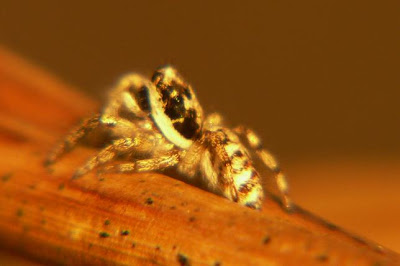Zebra Spider,
Salticus scenicus
Jumping Spider males will perform a courtship dance in which they not only wave the front legs, but "but femaleswill pick up the rapid vibration when the dancing male pushes down his abdomen. You can see this dance of another jumping spider specie, in this
video.
And if you scroll down to the (almost) bottom photos
here, you can see great photos of the Male (right) and Female (left picture) of our Salticus scenicus. The fangs of the male look enormous, which make me think that I got 2 females.
Ajumping spider does not catch its prey in a web, but instead it will stalk its dinner and pounce. Just before the jump, it will attach a silk thread, so it could always get back.
If you are intrigued by Spiders like me, and would love to find names to the pictures, the
Spiders of North west Europe is a nice website with lovely photos. At the bottom of the Home Page is a list of other eight legged websites globally.
I love the little Zebra Spiders. As regular readers of
Wildlife on Wheels will know. I have a few living around the outside walls of the house, and last year had one inside the kitchen. Despite their 5-7mm size, I usually spot one daily. Whenever I get outside, I do stop at the wall next to the porch, to check if one is there.
And of course, it would not pose for the camera, but rather keep on going wherever they think they need to go. With an incredible speed, while I follow it with the camera!
Another one lives on the other side at the front, always I haven't seen it for a couple of months now. I'm fearing it might be gone, as there were Grasshoppers and the much bigger Garden Spider, living in that corner of the garden also.
I saw them both at the same time in summer, otherwise I might be doubtful it being two different spiders. I've tried looking for individual features, but they are so small, that it is very hard to see on my images, and so I keep guessing.


Also, they are very curious and will often lift their head to observe that silly human who is watching this spider!




This Zebra spider I captured last year on my back wall. So I might have 3 about the place; mind you, I would not be surprised at all, if my one next to the porch had moved north to the back of the house, very near where I took most of the above pictures.

And a
Meta segmenta, I'd think. Please correct me if I'm wrong.






 We had just arrived and, as the Sun was out, in the middle of October, I headded outside with my cuppa. What was apparent, was that there were more Insects than during the summer! I had complained about the lack of Insects, but this time there were lots of flies trying to find something to eat. The Ladybird was the only one sitting still for a picture though. So here's a few other pictures of the garden.
We had just arrived and, as the Sun was out, in the middle of October, I headded outside with my cuppa. What was apparent, was that there were more Insects than during the summer! I had complained about the lack of Insects, but this time there were lots of flies trying to find something to eat. The Ladybird was the only one sitting still for a picture though. So here's a few other pictures of the garden.






A.JPG)





















